
In the previous Case History article, published in the May 2004 issue, some of the control problems encountered on the first visit to optimise two reheat furnaces in a steel plant were described. Open loop tests were performed on simple cascade secondary flow loops to establish valve problems, and very serious problems were encountered. This article continues with some of the problems found on the second visit. In the intervening period, valves had been serviced, and the new PLC system had been connected up.
Figure 1 shows an open loop step test on the furnace pressure control. It should be noted that the process gain (ratio of change in PV to change in PD) is about 0,2 - which is very small. This means that relatively large changes on the controller output result in only very small changes in pressure. In this case the implication is that pressure control is limited to a very narrow range.
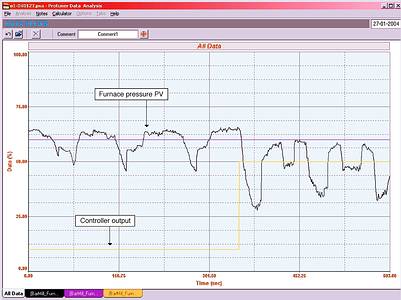
Also of interest are the large regular fluctuations of pressure of about 20% amplitude, with a period of about 110 seconds. The reason for this is the opening and closing of doors to push billets out of the furnace. There is no way that the feedback control can be tuned fast enough to catch these fluctuations.
Temperatures in the various zones are also affected by furnace pressure, but cannot vary fast enough to follow the pressure cyclic fluctuations in any significant way. The pressure is in fact controlled by quite a fast loop, so tuning the pressure controller in the normal way would have resulted in the controller trying to aggressively compensate for the fluctuations, which would have resulted in extreme shortening of the valve life. Therefore a special tuning was implemented, consisting almost purely of integral only control, which effectively 'averages' out the fluctuations and attempts to keep the average pressure at setpoint.
This is quite a slow tune, but it worked quite effectively as can be seen in the step change of setpoint test shown in the closed loop test in Figure 2. It can be seen that the tuning is relatively slow but does keep the average pressure at setpoint, and it certainly does work relatively well.
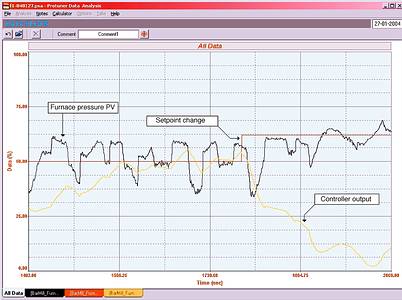
Figure 3 is an open loop test on the temperature control in the Preheat Zone on one of the furnaces. One can see how well the pressure kept to its setpoint even under the large load changes being caused by step changes in the gas and air flow loops being made during the test.
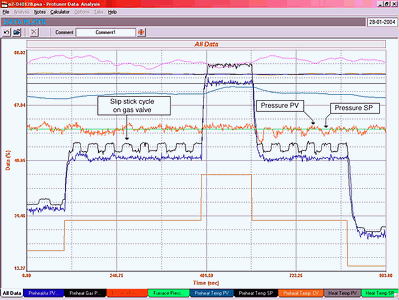
In addition one can also see a severe stick-slip cycle on the gas flow loop. Stick-slip cycles have been described quite a few times in previous articles. To summarise they are due to a valve problem and not to bad tuning, as many people seem to believe. The result is that we often find loops suffering from this problem terribly detuned, which results in very bad control. Although such cycles are not nice, it is better to tune the cascade secondary flow loop fast so that good temperature control can be achieved. Even with the stick-slip cycle, the average flow through the valve meets the temperature controller's demand requirements. (Stick-slip cycles can of course best be eliminated by slowing the integral down over a small gap around setpoint - as discussed in my Loop Signature article No. 8).
An open loop test on the heating zone of one the furnaces is shown in Figure 4. This displays interesting dynamics in the temperature response to a step test in the PD. The initial response in temperature is very fast, and then it slows down and starts ramping. This is sometimes referred to as 'a positive lead integrator'. What actually occurs is that when the step change is made on the demand, the sudden increase in combustion causes an initial fast rise of temperature directly in the ambient temperature inside the furnace. However the furnace load and walls are also starting to absorb heat and their temperature starts ramping up, which results in the overall temperature in the furnace also ramping up in an integrating fashion. This type of process requires a very special type of tuning which will be dealt with in a future issue in the loop signature series. If tuned correctly, normally spectacular improvements in performance are obtained, as compared to the original tuning usually encountered with this type of process dynamics.
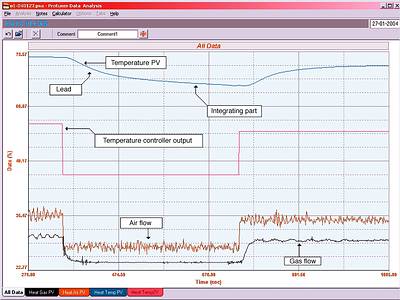
Figure 5 shows the temperature response to a setpoint change in a closed loop test on the same loop. This is really excellent, and shows just how good the tuning is. It is very, very much better than the original 'as found' tuning which literally took about 50 times longer to respond to a step change of setpoint of the same magnitude.
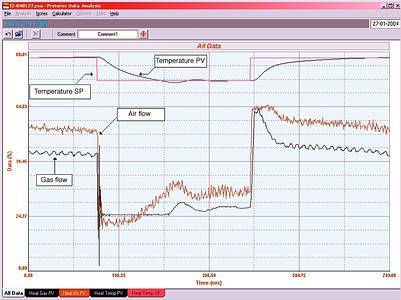
Something of interest that can be seen in the figure is the airflow response when the setpoint is stepped down. It goes into a very short-term cycle. However it does not do that when the setpoint is stepped up, and the response is very stable. This was in fact caused by an instability problem in the valve positioner. Even with this problem, the temperature control worked fine, once again proving the power of cascade control systems. If the temperature controller had been connected directly to the really poorly performing air and gas valves, it would only have been impossible to have such fine control.
Figure 6 shows an open loop test on a temperature control loop in one of the other zones in the same furnace. In the test the controller output is moved from zero to 93%. The actual change in temperature over that range was a mere 2% of span, which was equivalent to 20°C movement. This shows there is a major process problem in this zone, and the temperature is effectively uncontrollable.
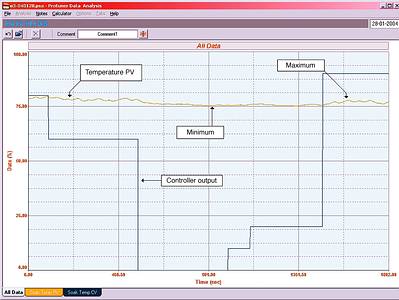
The last (and very interesting) example, which is shown in Figure 7, is of a gas flow loop. The valve that had purportedly been serviced between the two visits, was behaving even more badly on the second visit. In the figure one can see that the valve actually reversed direction whilst being opened! On reversing the controller output and trying to close the valve the valve more or less stuck at the same position for quite a while, and then suddenly opened further before starting to close. It is absolutely impossible to try and achieve any sort of control with a valve like this.
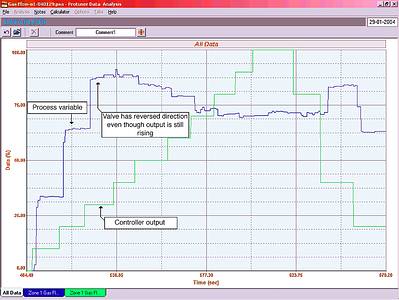
These examples are typical of the many control problems and challenges found in the average plant. It still amazes me that people are generally not aware of these things, and very few plants make any effort at all to even try and make their control systems operate properly, in spite of the fact that those control systems cost them a huge amount of capital.
Michael Brown, Michael Brown Control Engineering, (011) 486 0567, [email protected], www.controlloop.co.za
Michael Brown is a specialist in control loop optimisation, with many years of experience in process control instrumentation. His main activities are consulting, and teaching practical control loop analysis and optimisation. He gives training courses that can be held in clients' plants, where students can have the added benefit of practising on live loops. His work takes him to plants all over South Africa, and also to other countries.
| Email: | [email protected] |
| www: | www.controlloop.co.za |
| Articles: | More information and articles about Michael Brown Control Engineering |

© Technews Publishing (Pty) Ltd | All Rights Reserved